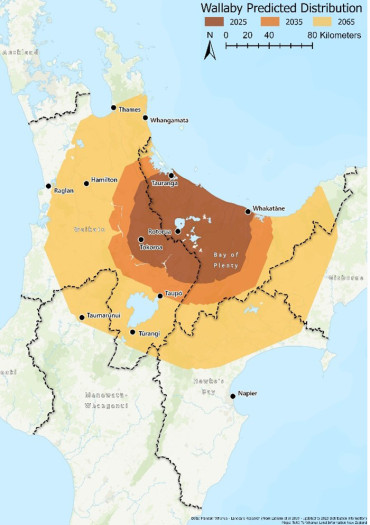Wallabies have been spreading to new areas
Wallabies are very mobile. It is estimated that on average, populations can spread up to 2 kilometres every year.
If left unchecked, it is estimated that wallabies could result in $84 million a year in damages and occupy one-third of New Zealand by 2065. The costs of wallaby damage are expected to increase annually.
Maps of predicted wallaby spread and distribution in New Zealand


Show/hide information on these maps
The first map shows the central North Island, with current and predicted distributions of dama and parma wallabies shown on it. In the North Island in 2015, wallabies could be found around Rotorua. They reached as far north as the Bay of Plenty coast. It was predicted that by 2020 wallabies would have spread to the edge of Tauranga in the northwest. By 2025 they could reach as far as Whakatāne in the east. By 2035 they could spread to Taupō. It was predicted that by 2065 their range could reach:
- Hamilton and into the lower Coromandel in the northwest
- past Tūrangi in the southwest
- as far as northern Hawke's Bay in the southeast
- through Te Urewera National Park in the east.
The second map shows the central South Island, with current and predicted distributions of Bennett's wallabies shown on it. In the South Island in 2015, wallabies were mostly found in southern Canterbury. This population was around Lakes Tekapo and Pukaki and almost reached the coast at Oamaru and Timaru. Small numbers occurred in Otago east of Wānaka with a couple of sightings further south. It was predicted that by 2020 and 2025 the ranges of these populations would have increased. By 2035 the southern Canterbury and Otago populations were expected to have merged. By 2065, it is expected that the southern Canterbury and Otago population of wallabies will have spread south into Otago and north into more of Canterbury.
[End of the maps' description]
Wallabies are spreading fast
These animated maps on YouTube show how quickly the predicted spread of wallabies would occur in the North and South islands if wallabies are left uncontrolled.
Stopping the spread of wallabies
Wallabies are classified as an unwanted organism under sections 52 and 53 of the Biosecurity Act 1993. That means they cannot be bred, sold, moved (transported), or exhibited without a permit. There are fines of up to $100,000 and/or 5 years in jail for those individuals who do.
They can breed from a young age, which means populations can build quickly if not well managed.
Find out how you can help stop the spread of wallabies
About Kawau Island's wallabies
Kawau Island in the Hauraki Gulf has parma, dama, and swamp wallabies. The Tipu Mātoro National Wallaby Eradication Programme is supporting the work of Auckland Council to eliminate wallabies to make the island pest-free.
Kawau Island pest eradication proposal – Auckland Council
Tipu Mātoro National Wallaby Eradication Programme
Find out more
Review of current and future predicted distributions and impacts of Bennett's and dama wallabies in mainland New Zealand [PDF, 2.3 MB]
Control and monitoring of pest wallabies – Bionet [PDF, 2.8 MB]









